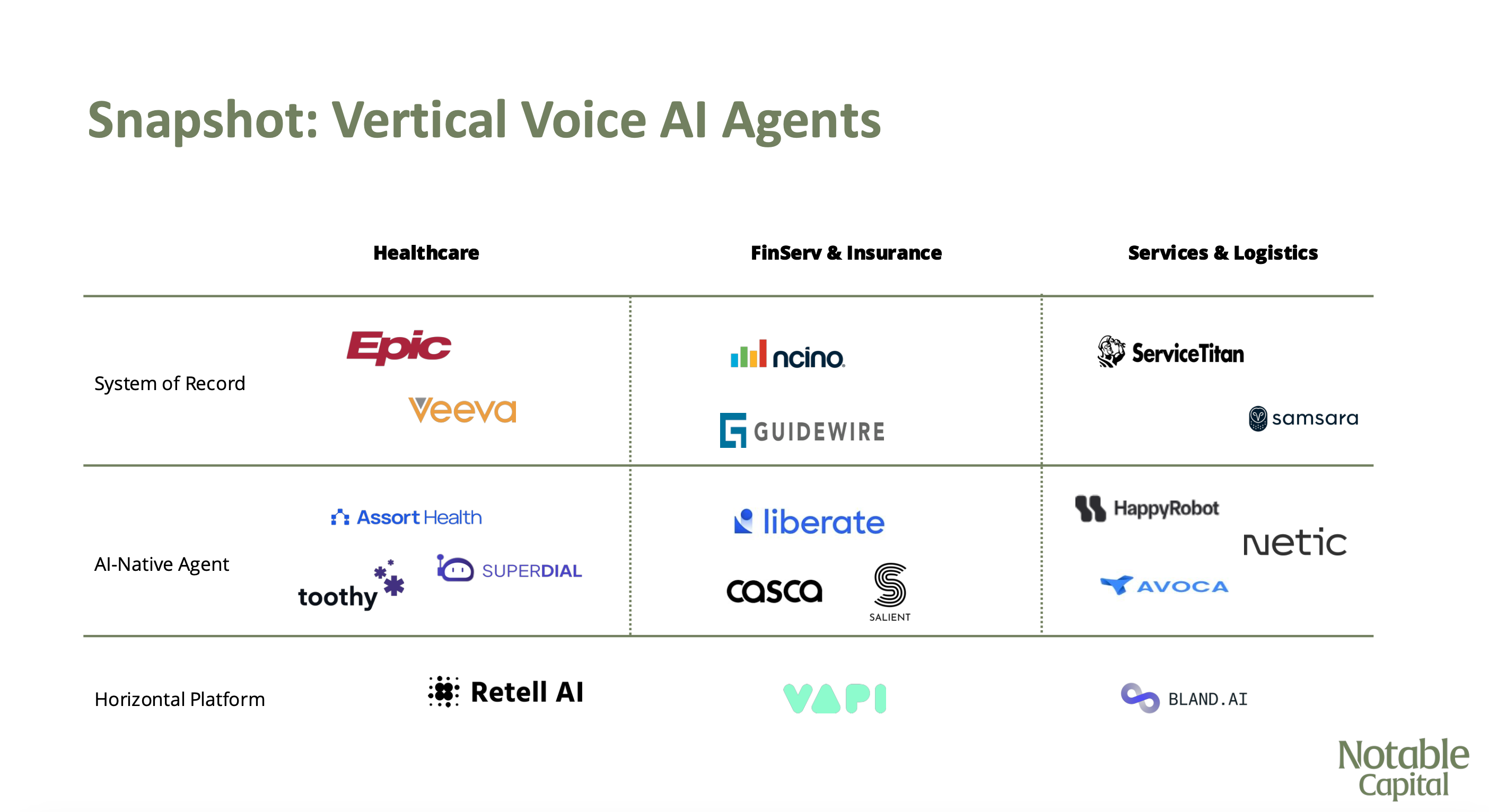0 Results for ""
Vertical Voice Agents Are Taking Off: Here’s Why

In the last year, we’ve witnessed an explosion of interest in voice AI. Much of this momentum is driven by rapid advancements at the infrastructure layer that make it easier to build and customize voice agents. Just last week, OpenAI released a new suite of audio models and open-source orchestration projects like Pipecat are gaining traction with developers. While we’re closely tracking many of these infrastructure players, what excites me most is how these advancements create the right conditions for a new wave of voice AI applications to emerge. Among the many approaches to voice AI, I’m particularly excited by vertical voice agents, voice-powered assistants purpose-built for specific industries or domains.
Having partnered with several vertical SaaS companies like Slice* and Brightwheel*, I've seen how founders that deeply understand a particular industry can build multi-hundred million dollar businesses. ServiceTitan is one of the most well-known recent success stories going public last winter, but we’ve seen this play out over decades with companies like Veeva ($VEEV) in healthcare, Procore ($PCOR) in construction, and AppFolio ($APPF) in real estate. Over the past year, more industry-specific voice AI agents have come to market, tackling some of the same markets from the vertical SaaS era.
Why are vertical voice AI agents taking off? I’ve identified three key factors that are driving their success.

1. Vertical-Specific Use Cases Facilitate Higher Reliability
One of the biggest advantages of vertical SaaS is the ability to reuse industry-specific knowledge across customers. We now see the same dynamic at play with vertical AI voice agents.
Companies in the same industry follow similar conversation patterns, allowing vertical AI startups to pre-train agents on well-defined use cases, improving accuracy, reliability, and deployment speed. This reduces the need for extensive customization while ensuring AI agents handle industry-specific calls with greater precision – a key advantage in vertical voice AI, where comprehension, response latency, and turn taking impact usability.
By leveraging industry expertise, vertical voice AI companies can showcase their agents’ ability to understand call context, follow appropriate workflows, and deliver a human-like caller experience – removing a key barrier to adoption. For example, companies like Assort Health use their healthcare focus to develop AI agents and standardized use cases for specialty clinics, like orthopedics or dermatology, where customers are generally asking the same kinds of questions. Trained on broader healthcare industry requirements, these agents handle general healthcare tasks like patient intake while adapting to specialty-specific nuances – giving customers the flexibility they need without having to build a fully customized voice agent.
2. High-Call-Volume Industries Represent Ripe Customer Opportunities
Most vertical AI voice agents are designed for industries with high call volumes and limited staffing capacity – such as healthcare, trades, and financial services. In these sectors, phone calls are critical to daily operations and, importantly, revenue generation. However, labor shortages and rising wage pressures make it difficult to meet demand. Because of this dynamic, every missed call or poor customer interaction can directly reduce NPS and lead to lost revenue. AI voice agents reduce this tradeoff by handling routine calls, allowing businesses to capture more customer interactions without being limited by human availability. Unlike traditional software, which often requires ripping and replacing legacy systems, voice AI sidesteps this friction – its true competition is labor, not software. This is a dynamic we’re increasingly observing agent companies navigate and believe is a massive opportunity if effectively executed.
For example, companies like Avoca are focused on the skilled trades – HVAC, electrical, plumbing – where over 80% of bookings happen by phone, and staffing challenges are acute.1 Avoca’s AI agents help these businesses manage after-hours inquiries, automate workflows like follow-ups, and even provide real-time coaching. The value proposition is clear: AI voice agents offer an immediate, cost-effective solution to increase revenue, helping voice agent vendors accelerate go-to-market conversations with business owners.
3. Industry-Specific Voice Agents Unlock Customers Across SMB and Enterprise
Many voice agent companies are strategically targeting verticals that span a broad range of customer sizes – from SMBs to enterprises. Traditionally, vertical SaaS companies had to pick a lane: either build toward enterprise-grade requirements with significant investment in product and go-to-market (GTM), or pursue a high-volume, lower-complexity SMB model. With voice AI, that paradigm is shifting, meaning larger TAMs.
SMBs are emerging as early adopters – not necessarily because they’re more innovative, but because they clearly recognize the efficiency benefits of voice agents and often lack the technical resources to build in-house solutions. By acquiring SMB customers in concert with selling into enterprise customers, voice agent companies establish early revenue and, critically, gather real-world conversational data to improve their models. This data flywheel helps them progress toward more complex enterprise use cases. That’s why companies like Retell, who provide a horizontal orchestration platform with great success in healthcare use cases, showcase both SMB and enterprise logos on their customer pages – something rarely seen in early stage vertical SaaS companies.
While the enterprise market remains the larger long-term opportunity, SMBs shouldn’t be underestimated. They represent 99% of U.S. businesses – over 35 million companies – and their adoption of voice agents is accelerating.2 Some of the historical challenges of serving SMBs, like churn, may begin to fade for voice agents. The simplicity of packaged voice agents drives faster onboarding and creates a retention moat: SMBs often lack the technical capacity to replace or rebuild these systems. We're seeing an interesting broader trend emerge: because voice agents interact directly with end customers, businesses – ranging from SMBs to enterprises – are increasingly hesitant to swap them out and risk disrupting the customer experience. As a result, we have optimism that vertical voice agents may have the opportunity to service larger markets.
The Future of Vertical Voice Agents
Looking ahead, the next phase of growth for vertical voice agent companies will come from moving deeper into industry workflows to effectively augment larger parts of labor, unlocking a business opportunity that could even surpass the impact of vertical SaaS over the past two decades. We’re already seeing chat-first platforms move into voice, and it’s only a matter of time before voice-native companies make the leap into chat, email and more. As we continue to watch this space closely, we’re excited to share more of our evolving thesis and connect with promising founders building voice agents.



.png)
